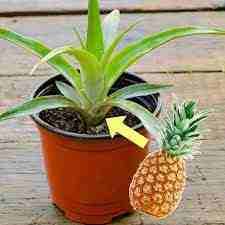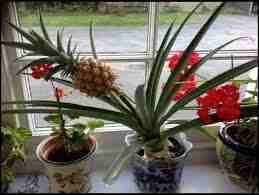Are you aware of the possibility of growing your own fruit? It is possible to do it virtually anywhere, with only some ingredients. If you are within USDA zones nine and higher, You can plant pineapples in your garden. If you’re not, it is usually one of those scrap-based projects which start by using a pre-made pineapple purchased from a supermarket and a sharp knife, the largest pot, and pot soil. Also, it’s a great opportunity to increase the speed of your thumb. One of the essential requirements in this endeavor is perseverance, as it takes, on average, three years for the plant to yield a delicious and juicy fruit that is edible.
How Long Before A Pineapple Plant Produces Fruit?
If you are eagerly waiting for the fruit of your pineapple plant, be prepared to be waiting for around two years, on average. As we mentioned, it is best to be patient until the pineapple blooms (produce suckers), and that’s where the future pineapples you’ll see from.
It is a good thing that suckers generally need around 18 months for them to develop, meaning that pineapples could be on the way. It is also important to take into account the amount of sun as well as water and other nutrients that a plant needs and how this affects the timing of the fruit’s development.
Given the fact that this plant is tropical, it is important to make sure your pineapple plant receives ample sun and water in the initial two years.
The fruit can be a challenge, and everyone’s waiting time is different. The best time to let your fruit ripen is when you see that they are forming, and all in all, it can take two years and possibly an additional month or two.
Different Methods of Planting Pineapples

There are a variety of methods to cultivate the pineapple plant. You can always consider making it start from seed, but it’s the longest way to grow it. There are other options, such as using one of the sides, slips suckers, hapas, or raccoons. In addition to the most obvious, the other methods mentioned are the things that plants leave after it blooms or fruit and then end their life.
Planting Pineapple Crowns
Crowns form the top part of a fruit, similar to those that are on the fruits in a supermarket. This is the most favored and simple method of establishing an entire pineapple plant. Take the leaves from the top with a soft grasp and then wrap them around the fruit. Then, twist the leaves to remove them carefully.
Important to remember: If there’s a hole cut through the crown part of the fruit, it will not be able to grow the fruit. A few fruit producers drill holes into the Crown. This is done to stop people from attempting to grow the Crown.
If you are planning to use crowns, you should know that this will require the longest amount of time to develop and bear fruit. There is a need to play according to your personal choices and determine what seems the most efficient.
Planting Pineapple Suckers
Suckers also grow out of peduncles and tend to be larger and more mature. They are able to grow out of buds which means it is necessary to cut them with a knife to get them out.
As they are prone to bloom in the spring, they can affect production and harvesting. You can plant an herb from the beginning. However, be aware that you might encounter some issues.
Gardeners are unanimous about this species being the fastest in its growth, as the fruit begins to appear within 16 months. The “ratoon crop” forms if the suckers are not watched over in the peduncle.
How Pineapples Grow

Pineapples may be the most identified plant from more than 3000 varieties within the Bromeliaceae family. From Tillandsias (air plant) to the fruit in and of themselves, bromeliads possess one of the fascinating cultivating habits of the kingdom of plants.
The pineapples do not reproduce from seeds. Seeds of wild plants are pollinated by hummingbirds and bats. The fruits resulting are small, seedy, and less affluent. Seeds are also tiny, as well as hard, and challenging to germinate, so gardeners begin by using suckers, slips, and crowns. Ratoon crops (second fruiting) are also possible with certain varieties of pineapple.
When it is planted in the ground or inside a pot, the fruit develops over three phases of growth, which last for three years, with the beginning phase being the longest. The characteristics of the fruit depend on the variety of plants and their growing conditions, but many plants will are dead after three years.
Vegetative Phase
After being rooted in the soil, the plant starts to expand rapidly, forming large, waxy leaves (up to 6 feet) that are either smooth or spiny. The longest time period is for up to 24 months, and it will most likely be a mystery to you as to whether the plant ever does any other thing than grow leaves.
Fruiting Phase
If the plant matures between 16 and 24 months, the stem becomes longer, with the tip becoming larger. It is in the flowering phase. Flowers appear, surrounded by more compact leaves known as bracts. Encouraging blooming may be difficult, and you’ll want as many blooms to emerge as much as possible. A small drop in temperature can trigger the process. An apple that is ripe and placed into the leaves create an ethylene gas, which is known as”ripening hormone” “ripening hormone. “1 Commercial grower employs the same hormone or chemical solutions for speeding up the flowering process. Inflorescence is a cluster that can be as large as 200 self-sterile plants which produce fruits that are not pollinated. A syncarp (fruit) comprises more than 100 flowers, the ovaries (berries) joined together. After the flowering process is complete, it takes up to six more months to allow the fruit to fully mature, and just one fruit is created per year.
Sucker Growth Phase
The plant that is the parent doesn’t technically create an additional fruit. The suckers and slips may develop and result in additional fruiting within 18 months. If left in the plant that is parent, the second harvest is referred to as a ratoon harvest. Smaller secondary fruits, which is why the method is seldom employed by commercial growers. Removing the fruit two or three weeks after the first harvest, the pups will produce higher quality fruits when they are grown as fresh plants.
Can I Grow Pineapples Indoors?
Yes! If your location isn’t suitable for tropical conditions, you could surely try to grow pineapples indoors. It is essential to provide your fruit plenty of room as well as light and water inside.
If you consider that the species could grow up to six feet wide and six feet high, It is unlikely that everyone has enough room for it. If you do have an outdoor greenhouse, garage, or patio with a screen, the pineapple plant can be able to move there.
Also, it’s worth noting that a pineapple grown indoors takes longer to mature as compared to one grown outside. In particular, the majority of gardeners report waiting around three years to produce fruit. This is approximately 12 months more than an outdoor one.
As long as you’re willing to endure the wait, the project should be an exciting undertaking.
In addition, they are also tolerant to indoor cultivation and, despite the fact that the time to fruit is a little longer, your plant is likely to prosper provided it is given sufficient sunlight.
How can I grow a large amount of pineapple quickly?
I’m afraid to inform you that there’s no time limit to this plant.
The plant must be able for it to be able to bloom and bear fruit. It is essential to allow sun, soil, and temperatures to assist the growth of leaves.
A few gardeners suggest spraying leaves with dilute low-strength fertilizer can help move to speed up the process. It is suggested that you might consider adding some coffee grounds in the planter or in the soil around it in order to give you some nitrogen to the pineapple plant.